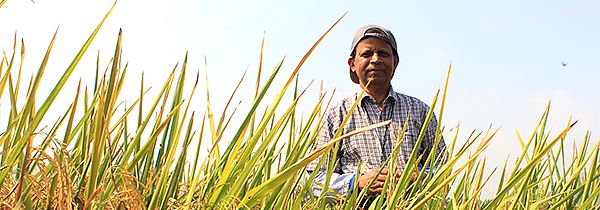A lot has been written about the Green Revolution in the late 1960s, which helped prevent mass famine. IR8, the first rice variety released by the International Rice Research Institute (IRRI) and the world’s first high-yielding rice variety, sparked the Green Revolution in Asia. This scientific innovation was soon followed by other high-yielding varieties that each offered increasing vigor and resistance to pests and disease—the major scourges of that period. These varieties were also adaptable where they were most urgently needed: the Philippines, Vietnam, Burma (now modern Myanmar), Cambodia, Indonesia, Malaysia, and India.
However, since the 1970s, rice yield potential had stagnated, particularly in tropical indica rice cultivars. There had been no significant yield improvement in inbred rice cultivars after the Green Revolution. Scientists at IRRI who had been working on finding out why had come to a game-changing breakthrough.
Dr. Kshirod K. Jena, a principal scientist at IRRI whose research has been on breaking the yield barrier of rice using genomics strategy, and his team discovered that the gene Gn1a-type 3 allele had not been very effective in indica cultivars. They then introduced the OsSPL14WFP allele into indica cultivars. The results were phenomenal. Normal indica varieties yielded an average of 5 to 7 tons per hectare. The new OsSPL14WFP allele-infused varieties produced 60 percent higher yield, resulting in 8 to 13 tons per hectare.
In addition to higher yield, the introgression strengthened the panicle and plant architecture, which means the panicles of the new lines could now support higher grain numbers without lodging or falling over.
“IRRI is now the leading institute in the world for introducing epigenetic allele into rice,” Dr. Jena said. “With the successful introgression of a functional epigenetic allele into elite indica rice genomes, we are redefining best practices in applying genomics tools to increase the yield potential of rice.”
Dr. Jena and his team used 12 rice varieties. Out of the 12, 4 are bred by Centro Internacional de Agricultura Tropical (CIAT) or International Center for Tropical Agriculture. Of the 8 IRRI-bred varieties, 4 are high-yielding lines from the International Network for Genetic Evaluation of Rice.
Dr. Jena is excited about the impact that this research could potentially have in rice production. With the global population rising continuously, urbanization rapidly reducing land for farming, and climate change threatening stable crop production, a significant improvement in genetic yield potential is one of the most crucial goals in rice research. “With our findings, we may yet pull off another green revolution,” Dr. Jena said, smiling.
The findings of this groundbreaking research was published in Nature.com.

